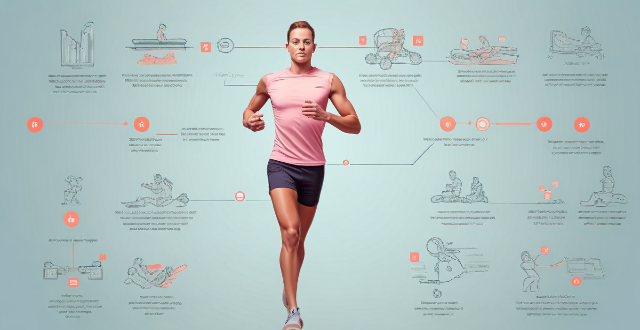Intensity Marathon

How often should I run during marathon preparation ?
Running is an essential component of marathon training, but how often should you run during preparation? This article will explore the optimal frequency and duration of running sessions for marathoners in their preparation phase. The importance of running cannot be overstated as it helps to build endurance, improve cardiovascular health, and increase muscle strength. The right frequency of running depends on your fitness level and the intensity of your training plan. Beginners should start with one or two runs per week and gradually increase the number as fitness improves. Experienced runners may be able to run four or five times per week without overtraining. The duration of each running session also depends on your fitness level and the intensity of your training plan. Beginners should aim for short runs at a moderate intensity while experienced runners can run longer distances at a higher intensity. Overtraining can lead to injury and burnout, so it's essential to listen to your body and give yourself enough recovery time between runs. Other factors such as terrain, weather conditions, and personal preferences can affect how often you should run during marathon preparation. It's important to adjust your training plan accordingly and avoid running in extreme conditions if possible. By following a well-structured training plan and adjusting your workouts based on personal preferences and environmental factors, you can achieve success in your marathon race!

What is the role of cross-training in marathon preparation ?
Cross-training is a vital component of marathon preparation that involves incorporating different forms of exercise into your training routine to improve overall fitness, prevent injuries, and enhance performance. The benefits of cross-training include improved cardiovascular fitness, reduced risk of injuries, enhanced muscle balance and flexibility, and a mental break from running. Some types of cross-training activities include cycling, swimming, yoga/Pilates, and strength training. Incorporating these activities into your training routine can help you achieve your marathon goals.

How do I choose the right shoes for marathon training ?
When it comes to marathon training, having the right pair of shoes is crucial. Not only do they provide comfort and support during long runs, but they also help prevent injuries and improve performance. Here are some key factors to consider when choosing the right shoes for marathon training: - Determine your foot type (flat feet, high arches, or neutral feet) and choose shoes accordingly. - Consider your gait (overpronation, supination, or neutral gait) and select shoes with appropriate features. - Choose the right type of shoe (trainers, racing flats, or trail shoes) based on your training needs. - Get the right fit by ensuring there is enough space in the toe box, the shoe feels snug but not constricting, and the heel fits securely without slipping. - Test before you buy by trying on shoes and considering different brands and models to find the perfect fit for your feet. - Don't skimp on quality by investing in a good quality pair of running shoes from reputable brands known for their durability and performance.

What is the ideal pace for a beginner in a marathon ?
When it comes to running a marathon, the ideal pace for beginners is an important factor to consider. It is crucial to find a balance between pushing yourself and avoiding burnout or injury. Here are some tips on determining the ideal pace for beginners in a marathon: 1. Start with a realistic goal 2. Use a training plan 3. Practice pacing during training runs 4. Consider your individual factors 5. Use online calculators and resources 6. Don't forget about recovery

What are the best training methods for a marathon ?
The article provides a summary of the best training methods for a marathon, including long runs, interval training, hill training, tempo runs, cross-training, recovery weeks, race pace workouts, and tapering. It emphasizes the importance of consistency, patience, and listening to one's body during training.

Is there a specific duration or intensity of exercise needed to improve immune function ?
The relationship between exercise and immune function is complex, but research suggests that regular physical activity can enhance the immune system. However, both the duration and intensity of exercise play significant roles in achieving this beneficial effect. The American Heart Association recommends at least 150 minutes of moderate-intensity aerobic activity or 75 minutes of vigorous-intensity activity per week for adults. Engaging in prolonged periods of endurance exercise can temporarily suppress immune function due to increased stress on the body. Light activities like walking or yoga can still offer immune benefits by reducing stress and promoting overall health. Regular moderate to high-intensity exercises, such as jogging, cycling, or strength training, are generally considered optimal for enhancing immune function. Adequate rest and recovery are crucial for maintaining a healthy immune system. Combining different types of exercises (aerobic, strength training, flexibility work) can provide a well-rounded approach to enhancing immune function. Staying hydrated and consuming a balanced diet rich in nutrients supports both exercise performance and immune health. Other lifestyle habits, including sleep quality, stress management, and avoidance of harmful substances, also play a vital role in supporting immune function alongside exercise.

How do I manage stress while training for a marathon ?
Managing stress is crucial during marathon training. Tips include setting realistic goals, following a structured plan, prioritizing recovery, staying hydrated and nourished, getting enough sleep, practicing mindfulness, seeking support, managing time wisely, and embracing the process. These strategies help minimize stress and make the training journey more enjoyable.

How do I prevent injuries during marathon training ?
Preventing injuries during marathon training is crucial for a successful and enjoyable race. To reduce the risk of injury, runners should warm up and cool down properly, gradually increase training intensity, incorporate cross-training, wear proper footwear, stay hydrated and well-nourished, schedule rest days, listen to their bodies, engage in strength training and flexibility work, and prepare for race day with pacing strategies and course familiarization. By following these guidelines, runners can minimize the chances of getting injured and maximize their potential for success on race day.

How does one train for a marathon if they have never done any extreme sports before ?
Training for a marathon can be a daunting task, especially if you have never done any extreme sports before. However, with the right mindset and training plan, it is possible to achieve your goal. Here are some tips on how to train for a marathon: 1. Set realistic goals based on your current fitness level, age, and time commitment. 2. Start slowly by incorporating walking or light jogging into your daily routine and gradually increasing the intensity and duration of your workouts. 3. Build up your endurance by incorporating long-distance runs into your training plan, starting with shorter distances and gradually increasing the length of each run. 4. Incorporate other forms of exercise into your training plan, such as swimming, cycling, or strength training, to improve your overall fitness level and reduce the risk of injury. 5. Focus on proper nutrition and hydration by eating a balanced diet that includes plenty of fruits, vegetables, whole grains, and lean proteins, and staying hydrated by drinking plenty of water throughout the day and during your workouts. 6. Prioritize rest and recovery by scheduling rest days into your training plan and getting enough sleep each night to ensure that your body has the energy it needs to perform at its best. 7. Seek professional advice from a coach or trainer who can provide guidance on proper form, technique, and training strategies to help you achieve your goals safely and effectively.

What is a good marathon diet plan ?
A good marathon diet plan should provide the necessary nutrients and energy to support an athlete's training and performance during a marathon. It should include a high-carbohydrate diet, protein needs, and healthy fats. A high-carbohydrate diet should provide around 60-70% of total daily calories from carbohydrates, while protein needs should provide around 10-20% of total daily calories. Healthy fats should make up around 20-35% of total daily calories. Good sources of carbohydrates include whole grains, fruits, vegetables, legumes, and low-fat dairy products. Good sources of protein include lean meats, poultry, fish, eggs, nuts, seeds, and plant-based proteins like tofu and tempeh. Good sources of healthy fats include olive oil, avocados, nuts, seeds, fatty fish (such as salmon), and dark chocolate.

What are the benefits of running a marathon ?
Running a marathon offers numerous benefits, including improved physical health like cardiovascular fitness and weight management, mental health benefits such as stress relief and discipline, social advantages through community involvement and charity fundraising, lifestyle changes leading to healthy habits and better time management, and personal achievement in overcoming challenges and creating a legacy. Overall, it's an activity that enriches various aspects of life and provides a platform for significant personal growth.

How can I avoid injury after a high-intensity workout
To avoid injury after a high-intensity workout, it is important to warm up properly, stretch, use proper form, take breaks, stay hydrated, and wear appropriate clothing. These tips will help reduce the risk of injury and allow you to continue enjoying the benefits of high-intensity workouts.

How does high-intensity interval training (HIIT) affect cardiorespiratory fitness ?
High-intensity interval training (HIIT) is a form of exercise that involves short bursts of intense activity followed by periods of rest or low-intensity exercise. This type of training can improve cardiorespiratory fitness by increasing the heart rate and improving blood flow throughout the body, leading to improved muscle performance and endurance. HIIT also helps to burn calories and fat, making it an effective way to promote weight loss. Additionally, HIIT workouts can be done in a shorter amount of time than other forms of exercise, making it a great option for those who are short on time but still want to stay active and healthy. Overall, incorporating HIIT into your workout routine can provide numerous benefits for your cardiorespiratory fitness and overall health.

Is high-intensity interval training (HIIT) beneficial for reducing stress ?
The text discusses the potential benefits of High-Intensity Interval Training (HIIT) for stress reduction, including releasing endorphins, improving cardiovascular health, boosting self-confidence, enhancing focus and concentration, and providing a sense of accomplishment. It also provides tips for incorporating HIIT into a routine, such as starting slowly, choosing enjoyable activities, setting realistic goals, incorporating recovery time, and seeking professional guidance.

Is it safe for elderly people to engage in high-intensity workouts ?
The safety of high-intensity workouts for elderly people depends on various factors such as health status, fitness level, balance and coordination, recovery time, and necessary modifications and adaptations. It is essential to consult with a healthcare professional before starting any exercise program.

How long should I train for a marathon ?
The length of time you should train for a marathon depends on your current fitness level, running experience, and goals. Most training plans range from 12 to 26 weeks. Beginners may need longer training plans of 18-26 weeks to build up their endurance and avoid injury, while intermediate runners may follow a 14-18 week plan. Advanced runners may be able to follow a shorter training plan of 12-16 weeks, but still need to build up mileage gradually and incorporate rest days to avoid burnout. Sample training plans are provided based on different levels of experience.

Is it necessary to do a warm-up even for low-intensity workouts ?
A proper warm-up is crucial for any workout, including low-intensity exercises. It increases blood flow and oxygenation, raises muscle temperature, improves range of motion, primes the nervous system, reduces injury risk, and boosts performance. Even for gentle activities like walking or yoga, a warm-up enhances mental focus, gradually activates muscles, promotes consistency, supports joint health, and eases into stretching. Warm-up ideas include walking, dynamic stretching, Tai Chi movements, Pilates exercises, and deep breathing or meditation. Incorporating a warm-up before any workout is essential for maximizing performance, reducing injury risk, and enhancing overall health benefits.

How does exercise physiology explain the benefits of high-intensity interval training (HIIT) ?
High-intensity interval training (HIIT) is a form of exercise that involves short, intense bursts of activity followed by periods of rest or low-intensity exercise. From an exercise physiology perspective, HIIT offers numerous benefits, including increased metabolic rate, improved cardiovascular health, muscle development and endurance, favorable hormonal responses, mental health advantages, reduced injury risk, and time efficiency. These factors make HIIT a popular and effective method for achieving various fitness goals.

Are there any risks associated with high-intensity workouts for seniors, especially in a group setting ?
High-intensity workouts in a group setting pose certain risks for seniors, including cardiovascular strain, musculoskeletal stress, overexertion and fatigue, and social and psychological factors. To minimize these risks, seniors should consult with a healthcare professional, start slowly and gradually increase intensity, focus on low-impact activities, stay hydrated and monitor temperature, wear appropriate footwear and clothing, listen to their body, and seek supervision from qualified instructors.

What kind of training do I need to participate in a marathon or trail run ?
To participate in a marathon or trail run, it is essential to have a comprehensive training plan that focuses on endurance, strength, speed, and recovery. This includes gradually increasing the distance of long runs, incorporating tempo runs and hill repeats for endurance, core workouts and lower body exercises for strength, interval training and fartlek for speed, as well as prioritizing adequate sleep and nutrition for recovery. Mental preparation techniques like visualization and goal setting can also be beneficial. On race day, pacing strategies, equipment checks, and a detailed race plan are crucial for success.

How does climate variability impact the frequency and intensity of extreme weather events like floods and hurricanes ?
Climate variability, which can be natural or human-induced, has a significant impact on the frequency and intensity of extreme weather events such as floods and hurricanes. Changes in rainfall patterns, sea level rise, and land use changes can increase the risk of flooding, while warmer ocean temperatures, atmospheric conditions, and El Niño Southern Oscillation (ENSO) can affect hurricane formation and intensity. As our planet continues to warm due to human activities, it is crucial that we take steps to mitigate the impacts of climate change and adapt to its effects on our environment and communities.

Can I purchase sports insurance for a one-time event, such as a marathon or triathlon ?
Can I Purchase Sports Insurance for a One-Time Event, Such as a Marathon or Triathlon? Yes, you can purchase sports insurance specifically for a one-time event such as a marathon or triathlon. Many insurance companies offer policies tailored to individual events, providing coverage for the duration of the event only. This can be beneficial for those who participate in occasional sporting events but do not require year-round coverage.

How does caffeine influence workout intensity and results ?
Caffeine can boost workout intensity and results by increasing energy levels, improving focus, and enhancing endurance. However, it's important to be aware of potential side effects like dehydration risks, sleep disruption, and dependency issues. Moderation and individualized consideration are key when incorporating caffeine into a fitness routine.

Is it necessary to stretch after a high-intensity workout
Topic: Stretching after a high-intensity workout Summary: The author believes that stretching is essential after a high-intensity workout for Americans. It helps to reduce muscle soreness and stiffness, improve flexibility, prevent injuries, increase blood flow, and promote recovery. Therefore, the author recommends incorporating stretching into their post-workout routine.

How long should my aerobic workouts be ?
Aerobic exercises, or cardio workouts, are vital for overall health and fitness. The American Heart Association recommends at least 150 minutes of moderate-intensity activity or 75 minutes of vigorous activity per week. This can be broken down into shorter sessions throughout the day. Starting slow and gradually increasing duration and intensity is advised. Mixing up activities helps prevent injury and keeps workouts interesting. Benefits include improved cardiovascular health, weight management, mood enhancement, and a stronger immune system. Always consult with a healthcare professional before starting any new exercise regimen.

Does high-intensity interval training (HIIT) have specific benefits for chronic disease prevention ?
High-intensity interval training (HIIT) offers numerous benefits for chronic disease prevention, including improved cardiovascular health, enhanced glucose control, reduced inflammation, increased muscle mass and strength, and improved mental health outcomes. To incorporate HIIT into a healthy lifestyle, start slowly, choose the right exercises, include other forms of exercise, and consult with a health professional.

What are some effective cardio exercises that can be done at the gym ?
Effective Cardio Exercises at the Gym Cardio exercises are an essential part of any fitness routine. They help improve cardiovascular health, burn calories, and increase endurance. Here are some effective cardio exercises that can be done at the gym: 1\. Treadmill Workouts 2\. Elliptical Machines 3\. Stationary Bikes 4\. Rowing Machines 5\. Step Mills 6\. VersaClimber/Vertical Climber 7\. Group Fitness Classes 8\. Other Machines

What are the benefits of interval training for runners ?
Interval training is a method of exercise that involves alternating periods of high-intensity activity with periods of low-intensity activity or rest. For runners, this means alternating between running at a fast pace and jogging or walking. Here are some benefits of interval training for runners: 1. Improved Cardiovascular Fitness: Interval training can help improve cardiovascular fitness by increasing the heart rate and breathing rate during the high-intensity intervals. This can lead to improved endurance and stamina, allowing runners to run longer distances without getting tired as quickly. 2. Fat Loss: Interval training is an effective way to burn fat and lose weight. The high-intensity intervals cause the body to burn more calories than steady-state cardio exercises like jogging or running at a consistent pace. This can lead to faster weight loss and a leaner physique. 3. Increased Speed and Power: Interval training can also help increase speed and power in runners. By pushing the body to its limits during the high-intensity intervals, runners can improve their muscle strength and power, which can lead to faster running times and better performance in races. 4. Time Efficiency: Interval training is a time-efficient way to train for runners. Because it involves short bursts of high-intensity activity, it can be done in less time than traditional steady-state cardio exercises like jogging or running at a consistent pace. This makes it an ideal workout for busy athletes who want to maximize their time spent exercising. 5. Reduced Risk of Injury: By incorporating periods of low-intensity activity or rest into their workout routine, runners can reduce their risk of injury from overuse or repetitive strain injuries. This is because interval training allows the body to recover between high-intensity intervals, reducing the stress on joints and muscles.

How often should I exercise to see weight loss results ?
To see weight loss results, start with low-intensity workouts and gradually increase intensity over time. Aim for at least 150 minutes of moderate-intensity exercise per week, mix up your workouts, and incorporate strength training. Consistency is key!

How often should I go to the gym to see results ?
The frequency of gym visits depends on fitness goals, current fitness level, and workout intensity. Factors to consider include: 1. Fitness Goals: - Weight Loss: 3-5 days per week of moderate to high-intensity exercise. - Muscle Building: Strength training 2-3 times per week with rest days. - Endurance Training: Run or cycle 3-4 times per week. - Flexibility/Yoga: Practice daily for best results. 2. Current Fitness Level: - Beginners: Start with 2-3 days per week and gradually increase. - Intermediate: Aim for 3-4 days per week of targeted workouts. - Advanced: Up to 5-6 days per week of specialized training. 3. Intensity of Workouts: - High Intensity: Allow for more recovery time; 2-3 intense sessions per week. - Moderate Intensity: Can be done 3-5 times per week. - Low Intensity: May be done daily, but focus on active recovery. Recommended routines vary depending on the goal, such as cardiovascular exercise and strength training for weight loss, compound exercises for muscle building, long slow distance and interval training for endurance, and daily practice for flexibility and yoga. Tips for success include setting realistic goals, mixing up exercises, listening to your body, and staying consistent. Rest days are important for recovery and growth.